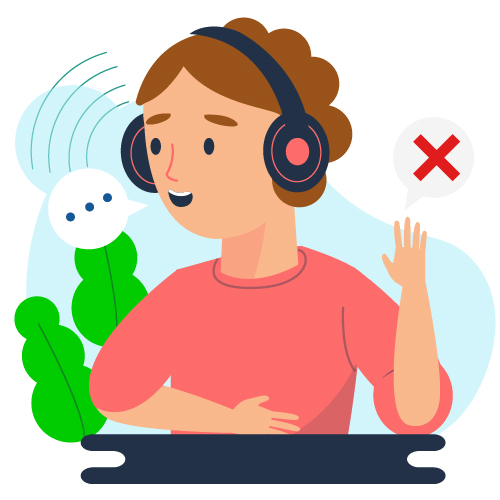IELTS Listening test: Avoiding Common Mistakes
Because recordings are only heard once, test takers frequently make more errors in the IELTS Listening test. The prospect of not being able to re-listen to a tape may be unsettling, but if you follow these recommendations, you’ll be in a lot better position to ace the test.
IELTS 2023 Syllabus – Following directions and comprehending the questions
The Listening test is divided into four sections, each of which has one or more sets of question types. Before and after each audio recording, you will be given instructions for each section of the Listening exam. You’ll also have time to prepare for each set of questions.
It is tough to concentrate on what you hear while also reading the questions, so make sure you:
- Before you listen to the tape, read the questions before.
- Examine the sort of response you must provide (e.g., a letter, an option from the box, etc.)
- Underline or circle key terms in the directions and questions using a pencil to help you focus on what to listen for in the audio.
- After the audio clip has finished, go over your answers and prepare for the next section of the test.
Recognize certain information
It might be tough to know which facts to use to answer a question at times. Certain inquiry kinds, such as form-filling, need you to listen intently in order to fill in specific information such as a name, date, time, or other specifics.
Make sure you understand the question by:
- Read the question carefully so that you understand what information you are looking for.
- Spend some time examining the material you’ve been provided before listening to the instructions.
- Consider synonyms for your keywords (words with comparable meaning), as the recording will utilize words or phrases that differ from the phrasing in your question booklet.
Following a brief description
Part 2 of the Listening exam consists of activities such as labeling a map, plan, or diagram. You’ll need to find out where things are, what they’re composed of, and how they operate. You may be assigned a task that requires you to identify locations, structures, parts, or phases of a process.
The recording will include some keywords to assist you. These keywords might be:
Adjectives and verbs (size, shape, quality)
Directions (north, east, south, west)
Positional or geographical prepositions (in front of, next to, behind)
If you’re not sure whether the side is left or right, or where north or south is, a simple idea is to write L and R on your question booklet and draw the compass points. This will make following directions easier.
Recognizing a dialogue
Part 3 of IELTS Listening requires you to follow a discussion with up to four speakers discussing a study-related topic. You will be required to listen for key facts, ideas, reasoning, points of view, or opinions.
It might be difficult to tell who is speaking and what they are saying, therefore always:
- Before you begin listening to the recordings, read the text.
- Take notes on the speakers, their relationships, and how it pertains to the scenario.
This might help you anticipate which speaker will speak next and what the speakers will discuss.
Following a lecture or presentation
Part 4 is frequently regarded as the most difficult in the Listening test since the level of difficulty increases as the test proceeds. Part 4 will consist of listening to a discussion or lecture on an academic subject (e.g. a university lecture).Listen for signpost words that the speaker uses to signal distinct stages of the conversation. Signpost terms can include, for example:
- Firstly
- the opposite hand
- Although
- Because
- only to name a few
- Finally,
These words indicate what information is coming next and can help you understand what the speaker is saying.
Also, pay attention to stress and intonation, since the speaker will utilize these to emphasize essential points.
Words matter.
The directions for the Listening exam will inform you how many words are in the solution. For instance, no more than ONE word, TWO words, and/or a number.
To prevent adding unnecessary words, carefully read the word-count guidelines and remember:
If the instruction specifies a single word and you write ‘the bus,’ your response will be deemed wrong, even though ‘bus’ is the right term.
It is allowed to write a number in words rather than digits. For example, ‘320’ is a number and counts as a number.
Spelling
In the Listening test, proper spelling is critical. If the spelling is incorrect, it will be indicated as incorrect. Check if you can correctly spell terms like library, environment, street, avenue, professor, and so on.
If you are taking the IELTS on paper, you will have 10 minutes to transfer your responses from the question booklet to the answer sheet. Remember to double-check your spelling, pay attention to the directions, and write the correct answers in the correct places.
As with any test, preparation and practice are essential for success. You may put yourself in the best possible position to succeed with practice and preparation.
You must know and use a specific technique for answering each type of question in the IELTS Listening section. Poor abilities in specific question categories, such as categorizing maps, provide a significant obstacle to IELTS applicants. It will be quite tough to acquire the correct answer if you are inexperienced with this question style. The greatest strategy is to study all of the different sorts of questions and techniques for answering them. In our online course, we study and practice all tactics.
Similarly, it is critical to focus on the keywords. How does it function? Before listening to the audio segment, you will have some time to read the questions. Look for keywords in the questions, highlight them, and pay close attention to them throughout the passage. This will not only give you a sense of what the section will be about, but it will also help you stay focused when listening to lengthy talks or a lecture.
Not double-checking your replies
You will write your responses on question sheets in the IELTS paper-based exam, and then you will have an extra ten minutes to transfer your answers into the answer sheet. You do not need those 10 minutes if you take a computer-based test and answer straight on the screen. You will only have two. The questions you have answered will be highlighted in the computer-delivered test.
Make certain that there are no blank spots. In IELTS Listening, incorrect responses do not result in a loss of marks. The power of probability may be used by guessing when there is a chance that the assumed responses are correct.
- Consider synonyms for your keywords (words with comparable meaning), as the recording will utilize words or phrases that differ from the phrasing in your question booklet.
- Spend some time examining the material you’ve been provided before listening to the instructions.
- Read the question carefully so that you understand what information you are looking for.



